The Lincoln Aviator is so thoroughly intended as a sanctuary that it comes complete with a symphony performance.
This is not in the form of tickets on the dashboard or the classical music station tuned on the radio; it’s integrated into the vehicle. Rather than those irritating beeps and dings that most cars make, the Aviator’s tones are short clips of instrumental music, recorded for this purpose by the Detroit Symphony Orchestra.
For those who have not looked at a Lincoln in some time, the Aviator offers legitimate reason to give the brand renewed consideration. The recent cadence of fully renewed products has been leading Ford’s luxury division along an uncharted path focused less on outright performance and more on serenity and refinement.
“When we look at our mantra of quiet flight—beauty, gliding, sanctuary, and warm—the Aviator is that opportunity to start from a clean slate with a new platform,” says Jim Rideout, product plans manager for Lincoln Motor Company of Canada. “Aviator has really gotten us to where we want to be and where we want to go forward.”
These descriptions meet reality in attributes such as a roof line in the shape of an aircraft wing and wheels styled after turbines—intentional plays on a classic aviation theme—as well as interior materials such as leather, open-pore wood, and chrome that mark distinct improvements over the black-on-black and plastic-plagued cabins that have haunted Lincoln for years.

Photo courtesy of Lincoln Motor Company of Canada.
A 3.0-litre twin-turbocharged V6 engine, producing 400 hp and 415 lb-ft of torque, is available now, and a plug-in hybrid Grand Touring model will be available by the end of the year.
Both versions greet the driver upon approach with what the brand calls the “Lincoln embrace,” which illuminates welcome lighting—including an optional back-lit Lincoln Star on the grille—and, when air suspension is equipped, lowers the ride height by 50 millimetres to offer easier access. That suspension can also employ forward-facing cameras to scan the road for obstacles such as potholes and lift individual wheels to help mitigate damage and keep the vehicle rolling smoothly.

Photo courtesy of Lincoln Motor Company of Canada.
The front seats are heated and ventilated by default and are available with 30-way adjustment and a massaging feature. The second-row outboard seats are also heated, as are the steering wheel, outboard mirrors, and wiper blades. Up to 80 settings for preferred seating and mirror positions, climate controls, audio volume, music selection, and more, can be saved to individual driver profiles that load upon detection of each driver’s key fob or configured smartphone.
“We’re going to offer something completely different in the marketplace,” Rideout says. “It’s not performance-driven. We’re not apologetic. That’s how we’re going to differentiate ourselves.
“We truly believe that when someone gets into that vehicle and they just take that first moment and close the door, it is a form of escape.”
For now, the Aviator is the only vehicle in the Lincoln lineup that manifests this future vision for Lincoln. But if this is a preview of what’s to come, then we should be all ears.
Read more Transportation stories here.









